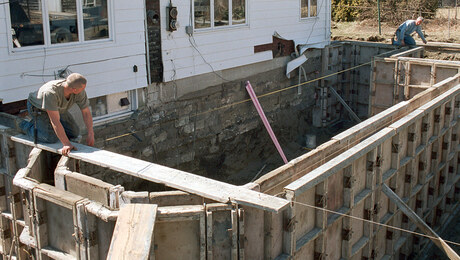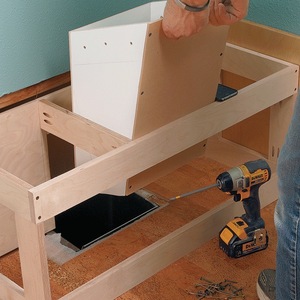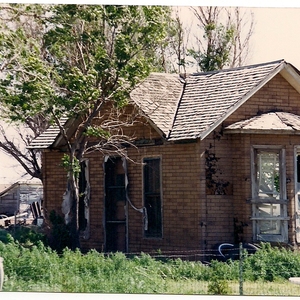Hello all – new to this forum – I hope I’m posting my question in the right place.
Learning as I go on my first home refurb about everything, with Taunton books help on several things. I have an electrical question.
My house has it’s 60 amp, old fused panel on the interior wall (shared with house) of the garage. Previous owner got as far as putting new weather head in and meter box on opposite outside wall of garage. No panel, no actual meter yet.
So the house needs to be totally re-wired which I’d like to try – as much as code will allow.
A bonus room sits above this garage which has a lower than normal ceiling. So there are floor joists as the ceiling of the garage. No sheetrock, just the exposed joists.
The question is this: What’s the best route for the circuit wiring from the new panel to get across the garage to the house? I’m planning on running the wiring through the attic area once I get across the garage.
Is it acceptable to run the wire from the panel through the floor joists for the bonus room (essentially the ceiling joists of the garage)? Or is it better to run all the circuits up into the ceiling of the bonus room somehow then across and back down into the attic of the house? This would use a lot more feet of the currently very expensive copper wire! 🙂
I didn’t know if there was anything inherently bad about running NM wire in the ceiling joists of the garage or against code.
Sorry for the long post – any help would be much appreciated.


















Replies
Cables are run in the joist all the time. Look in most any basement.
Now are the runs going to follow the joist or will they cross them.
If they are across them you need to drill holes for them.
But you can also install a running board and mount them to the running board. But that will cause problems if you want to DW the ceiling of the garage. And if this is inspected and you finish the room above the garage you will probably have to DW the garage ceiling.
.
A-holes. Hey every group has to have one. And I have been elected to be the one. I should make that my tagline.
How about running a main feeder line from the new location meter box back to the existing panel location ...basically a sub-panel I believe, I'm no sparky but I think this is do-able and code approved....this way you only have to run the service cable across the garage to the sub-panel, then run your circuit wiring from the sub-panel. If I'm wrong on this I'm sure someone will let you know :)
Geoff
That can be done. However, he need overload protection at the meter or just inside. Can't run the feeder unprotected.And it will only be part of the solution as the existing panel is only 60 amps. And almost likely all ungrounded wiring.So it depends on how much he is going to upgrade of the existing and where the loads, both existing and new.The basic options are.Install full panel at the meter and run all circuits there.Replace existing panel with sub-panel for the existing circuit and a all of the new circuits run to the main panel.Install a disconnect at the meter with a feeder to a "full size" sub-panel where exisitng fuses are. Except for a couple of local circuits everything would be wired to the sub-panel.
.
.
A-holes. Hey every group has to have one. And I have been elected to be the one. I should make that my tagline.
Thanks to all for the advice so far. To fill in/clarify some details of my question:
Local code allows me to do everything up to the panel. So I can run all new circuits, but not actually hook them to the new panel. Nor can I hook the panel to the incoming service - nor would I want to do that part.
I know cables are often run through and along floor/ceiling joists. I didn't know if a garage location is considered more of a risk to the unprotected NM cable than, say, a basement or attic due to garage doors, openers, etc. That's the main part I wasn't clear on - whether a garage location requires specific measures to protect the cable.
I had thought of running a feeder from a new main disconnect where the new service will enter, across the garage to a new panel, but I could have sworn I either read or someone told me that wouldn't be allowed. Not to mention the sheer cost of the heavy cable I'd need.
The entire old system is ungrounded, so my plan is to replace everything. I really don't want to use the old, outdated fuse box.
I have mused about changing the location of the new weatherhead, but most likely won't since the new meter base is already there and was drilled through the brick of the house. 50+ year old brick that would be very hard to patch with anything now on the market.
Thanks again for the advice. All good things to ponder.
"I had thought of running a feeder from a new main disconnect where the new service will enter, across the garage to a new panel, but I could have sworn I either read or someone told me that wouldn't be allowed. Not to mention the sheer cost of the heavy cable I'd need."You can't run UNPROTECTED feeder through the house. You need overload protection either on the outside or "immediatelY" inside (depends on the area sometime 1', sometimes 3', sometimes upto 6').It can either be just a 2 pole breakers. Or it an be a small panel with say 8 slots that will allow you to have a few local circuits and then run the big cable into the house for the majority of the loads.Now I have not priced wire recently. But most likely it will be cheaper to run one big cable and the all of the little ones..
.
A-holes. Hey every group has to have one. And I have been elected to be the one. I should make that my tagline.
Copper is up worldwide these days. The usual 14 and 12 gauge cables are running about $50 for 100' at the big boxes. Of course, there should be a better price on a 250' coil. At that price, you'd probably spend over $400 on wire for all the separate circuits, and the cost would be higher if there's a stove, dryer, or water heater circuit to deal with.I found a price on the web of $360 for 200' of 100 amp service cable. You wouldn't need anything like 200', of course, but you might want to use an even larger size wire to reduce resistance over the run. Probably cost a bit over $200.I'm sure that Bill is right about this being the less expensive way to go, even if you add in the cost of that circuit protection box. IMO, it would also be less work to string one big cable than 20-30 smaller ones.The main thing to me would be whether the cable would have to be routed across the joists or not. I would be reluctant to drill holes in the joists large enough to get this cable through. For that matter, I would be reluctant to punch 20-30 small holes in each joist to get the smaller cables through. I think I would use the large cable and run it in conduit for protection.George Patterson, Patterson Handyman Service
The wires WILL have to go either across or through the joists to get across the garage. I was a bit concerned about punching a bunch of small holes in these joists, too, for all the branch circuit wires. The joists for the bonus room above the garage don't seem as stout when I'm upstairs in the bonus room. Not solid like a real floor feels, so I was concerned. However, this particular garage has such a low "ceiling" that running cable in a conduit might be problematic too. I'll have to look closer at the whole thing.It's not an easy decision, at least for me.
Well, first thing to do is to check with your local electrical inspector to see what they'll let you do. Some areas won't even bother to inspect a residential DIY job, others won't let you do it at all. Most are somewhere in-between.
In general there's nothing wrong with running wires between ceiling or floor joists. It needs to be supported at regular intervals and needs to be protected from damage. The rules for this are pretty reasonable, though a particular inspector may get nit-picky and give you trouble.
As someone else said, it may be best to install the new panel more or less where the old one is (to be more centrally located) and run the main cable from the new meter location to there (generally with a fused disconnect near the meter). However, this particular subject -- runs of any distance between meter/disconnect and breaker panel -- is often subject to local rules, and may actually involve electic company rules in addition to electrical code, so you need to get it cleared with both authorities before you start.
One possibility is to get an electrician to wire from weather head to the new panel, placed next to the old, and either power the old panel from a 60A breaker in the new one or just go ahead and transfer the ten or so circuits in the old panel to the new one. After that, you can then do the rest of the upgrade at your leisure, on a separate permit.
When I upgraded the panel in my old house in Franklin, NJ, I ran a new service close to the old one. I put in the new panel right beside the old one. I hooked a jumper between the old panel and the new main breaker and transferred circuits.
Here, the homeowner can pull a permit, do the work, and arrange for the inspection. The power company has to make the final connections, and they do this at inspection time. When the time came, all I had to do was remove the jumper, hook up the new service connectors to the main, and have the company man switch the drop to the new service wires. Here, it's illegal to remove the meter without getting the permit first, and you can bet I pulled that meter before running my jumper wires. I also found that PSE&G would give me the new meter box when I showed them the permit. Saved me a few bucks.
You might want to consider taking that new service head down and moving it over near the existing one if you can pull the same trick. From your post, it sounds like you can't, though.
George Patterson, Patterson Handyman Service
Edited 4/12/2007 10:46 pm ET by grpphoto
2 more cents-
its "illegal" cause you dont own the meter, the electric comp does. That is why when you dont pay your electric bill they can come out and remove the meter. Now thats pretty hard core when you go look at a forclosed home that has no meter in the box. HA HA HA
Note that the rules with regard to meter base and mast vary widely from one place to another. You have to check with the local power co to see what their rules are.
So convenient a thing it is to be a reasonable Creature, since it enables one to find or make a Reason for everything one has a mind to do. --Benjamin Franklin
In most places you can just pull a meter for repairs and call them and they will reseal it.But in areas where there have been problems with bypassing the meter they can install an antitamper device..
.
A-holes. Hey every group has to have one. And I have been elected to be the one. I should make that my tagline.
No, it's illegal 'cause Jersey has a law against it.George Patterson, Patterson Handyman Service
I had a 100 amp box in my basement, with the meter and weather head on the back of my house. I added a 27' long family room on to the back of my house. I had a new meter, weather head and shutoff switch put onto the back of the new family room. I ran the huge feeder cable throught the 2x6 stud wall, through holes I drilled, into my basement and over to the box. I had the electrician put in a new 200 amp box and do the connections at each end, but I saved a lot of money by buying and drilling and installing that feeder myself. My electrician worked with me and told me exactly what to buy and where. I also ran a smaller feeder from the new box to a 100 amp sub-panel in my garage for my new workshop. He again hooked up the ends. Running those huge copper feeders was a challenge, but it saved $!